Technique Options
Contents of this bit
DL without pharmacologic aids
Scenarios:
Cardiac/respiratory arrest (a Code)
The patient is in a state of arrest and essentially needs to be intubated.
This is done by performing a DL and placing an appropriate sized endotracheal
tube. No topicalization or i.v. medication is given. The practioner must
remember that the patient may become somewhat alert during the procedure
and should be treated appropriately. Even in the situation of a difficult
intubation direct laryngoscopy is the best option as no other technique
can be as rapid and no time can be lost.
Awake Direct Laryngoscopy
Scenarios:
All Cases
Apparent Difficult Intubation
Known Dificult Intubation
Hemodynamically Unstable
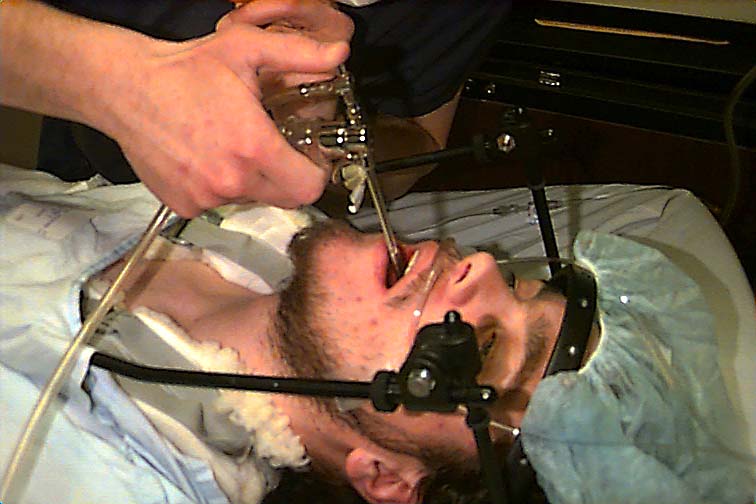
Topicalising with a DeVilbis spray
Topical lidocaine 4% is used to topicalize
the oropharynx and the hypopharynx (the nasal passage and nasopharynx is
done if nasal intubation is expected). Specific blocks for the superior
laryngeal and glossopahayngeal nerves can be performed.
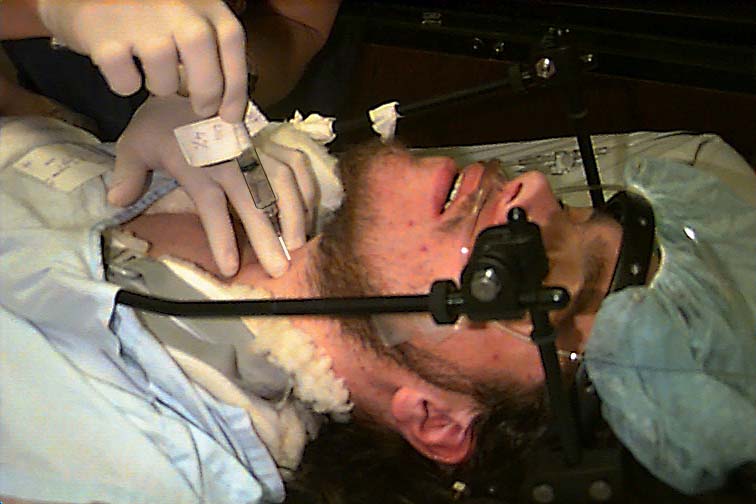
The transtracheal block for the recurrent laryngeal nerve can be performed.
However, the clinician must remember in performing these block the patient
will have no longer be able to protect thier airway against aspiration since
the mucosa above and below the cords are anesthetized. Topicalization without
the use of specific blocks may often be sufficient.
Sedation can be used if titrated slowly, so as
not to depress respiration, midazolam
0.5-1.0 mg titrated to effect or scopalamine
0.5 mg are good choices. If an analgesic is to be used, fentanyl
is an appropriate choice. The clinician must remember that the sedatives
and analgesics often have synergistic effects on respiratory depression.
The major benefit of Awake DL is that the patient is actively breathing.
This may cause the cords to move, placement of the ET should be timed when
the cords are open. If the tube touches the cords before placing it through
them, the cords may adduct closed and the clinician then has to wait for
them to open again. The patient may cough and buck with placement of the
tube, sedation of the patient may be required as soon as tube placement
is confirmed.
Awake Blind Nasal
Scenarios:
Unstable Cervical Spine
Uncooperative patient
Adequate topicalization is the key to success.
It is performed as in the awake DL. The nares should also be sprayed with
phenylephrine (0.5%-0.25%) nose drops to vasoconstrict vessels and shrink
mucos membranes. The nostril which the patient breathes easiest through
is selected. The endotracheal tube is lubricated with a water soluble jelly
and introduced below the inferior turbinate perpendicular to the face. The
tube is advanced and breath sounds are listened to through the tube, when
the tube enters the airway the patient will no longer be able to speak.
The trachea can be manipulated as needed. This can be technicallly difficult
procedure and can lead to complication such as epistaxis vomiting and aspiration.
It is contraindicated in basal skull fractures and midfacial trauma.
In a deeply unconcious patient this can be performed without topicalization.
This method is often used by paramedics in the field.
Rapid Sequence Intubation (RSI)
Scenarios:
Cardiac (Hemodynamically ) Unstable
Increased Intracranial Pressure
Burn /Crush/Spinal Cord Injury
Unstable Cervical Spine
This technique is commonly used in the operating rooms for all patients
who are aspiration risks. This same technique can be used effectively in
emergency intubation.
The patient is preoxygenated for 3 minutes. Having a pulse oximeter helps
to determine if the patients oxygenation is improving. The patient may remain
hypoxic in spite of preoxygenation because of their underlying condition.
The induction agent of choice is given followed immediately by a muscle
relaxant. The muscle relaxant most often used is succinylcholine.
In burns or crush or spinal cord injury succinylcholine may be contraindicated.
The patient is intubated under direct laryngoscopy when paralysed. Cricoid
pressure should be held as soon as the patient has been given the induction
agent and should continue to be held until tube placement has been confirmed.
There are modifications of this technique for different scenarios. See each
situation for discussion.
Fiberoptic
Scenarios:
Apparent Difficult Airway
Known Difficult Airway
Unstable Cervical Spine
This intubation technique requires a cooperative patient, a functioning
fiberoptic scope and skill. The patient must be
topicalized and this can be done as described above. An antisialogogue
should be given to the patient to help reduce secretions. Glycopyrrolate
is the usual choice, onset of action may be 30 minutes for the antisialogogue
effects and intubation may need to be performed sooner. The intubation can
be performed either nasally or orally,
nasal can sometimes can be easier. The fiberoptic scope should have some
way to remove secretions.
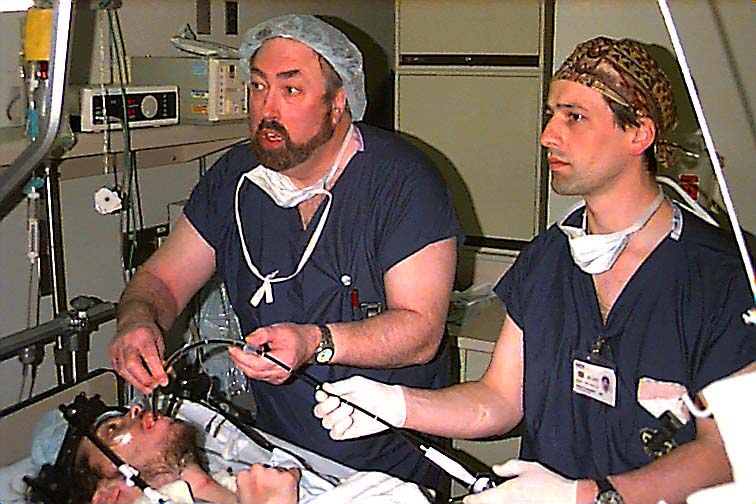 Fiberoptic intubation
Fiberoptic intubation
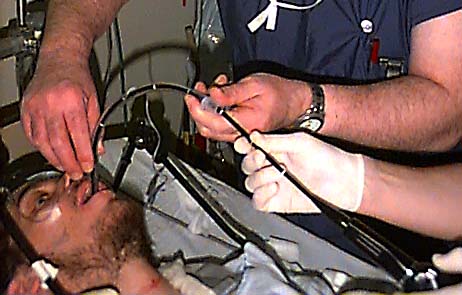 Passing the ET over the scope
Passing the ET over the scope
The major difficulties with this technique in the emergency situation are
that the patient is not usually optimised, i.e. an antisialogogue given
and allowed to work, the patient may not be cooperative, the topicalization
may be inadequate and difficult to perform. When performing this procedure,
the patient will not be receiving as much oxygen as previously given and
may desaturate rather abruptly. In summary, though this is an excellent
technique to use, in the emergency intubation it may be limited.
Surgical
Scenarios:
Apparent Difficult Airway
Known Difficult Airway
Unable to Intubate/Unable to Ventilate
The surgical airway consists of formal tracheostomy and cricothyrotomy.
These are most commonly used in the event of unable to intubate/unable to
ventilate. They may be first choice if the clinician feels that it is going
to be difficult to intubate the patient with other methods and that time
is crucial in securing the airway. In this case, the surgical airway can
be performed under local anesthesia.
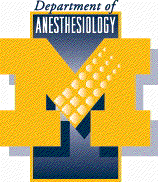 Go to Front Page
Go to Front Page 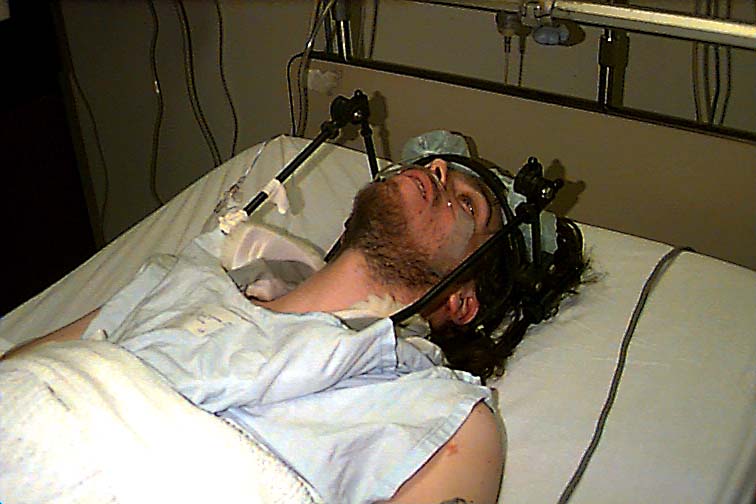 Go to Scenarios
Go to Scenarios  Go
to Techniques
Go
to Techniques